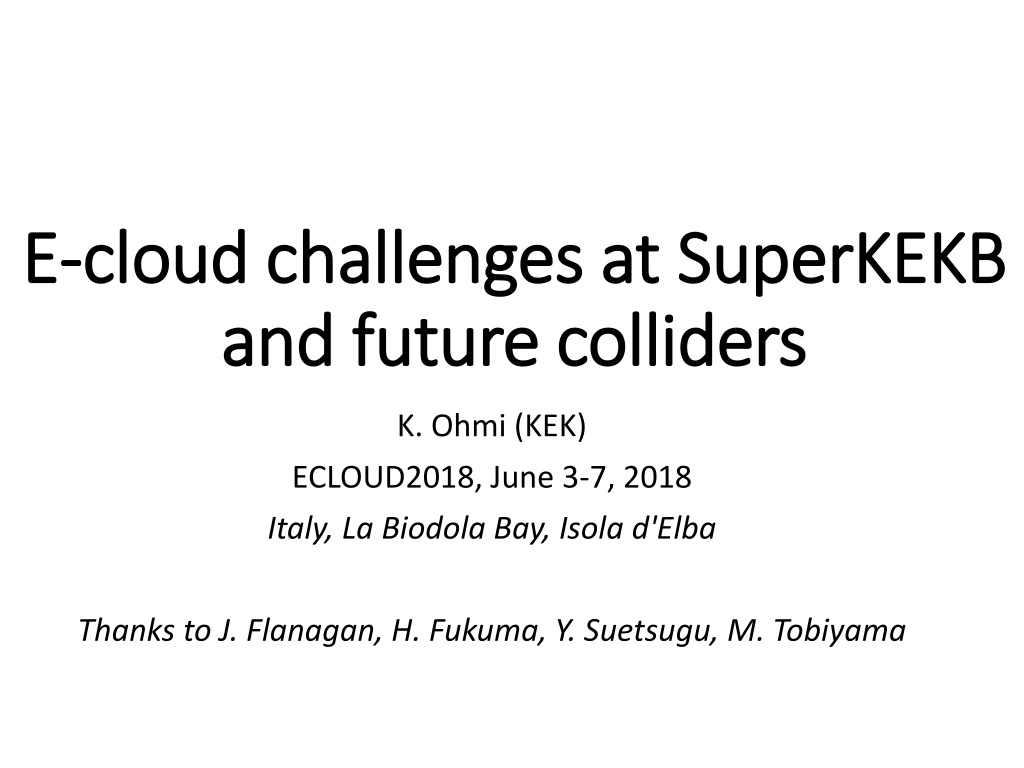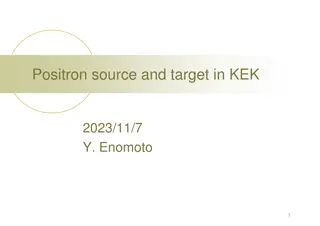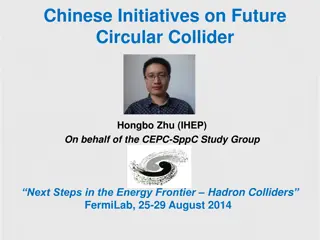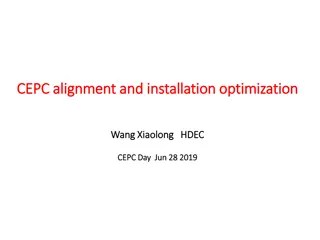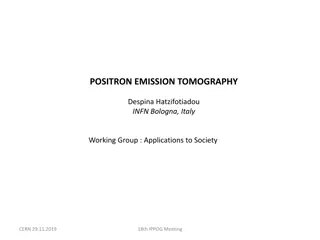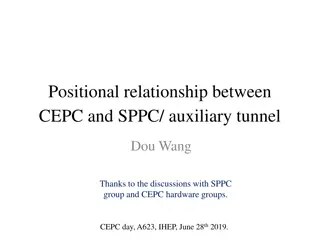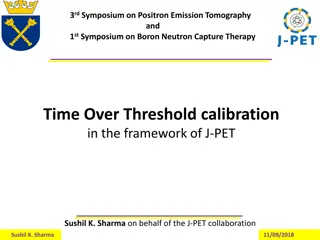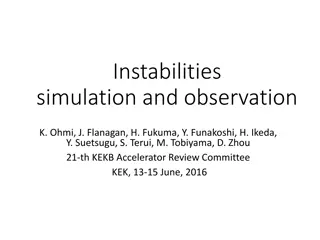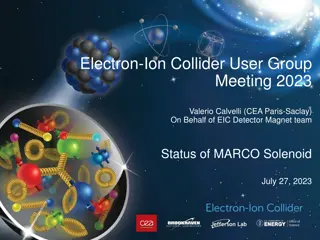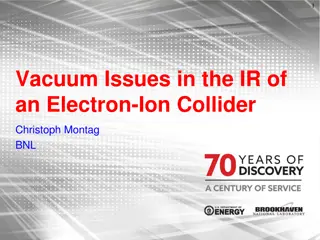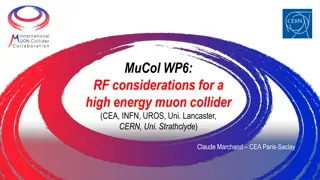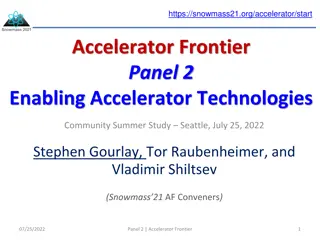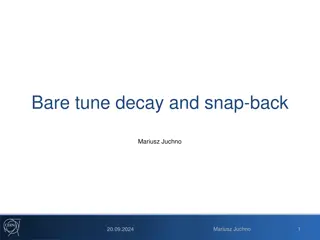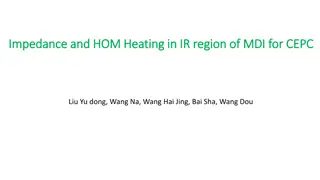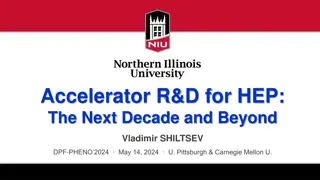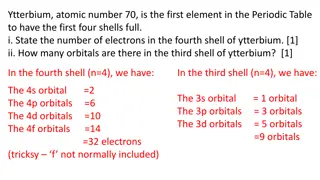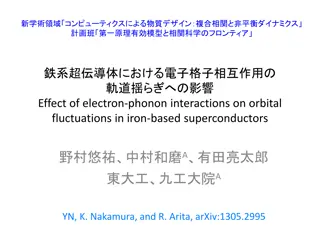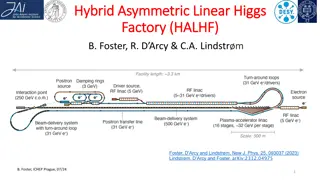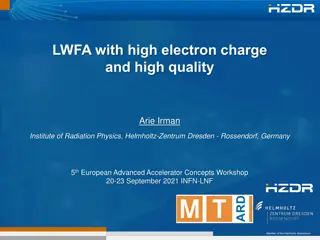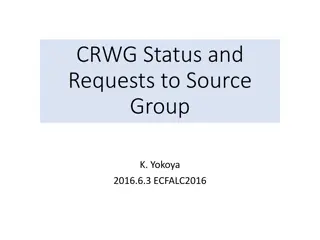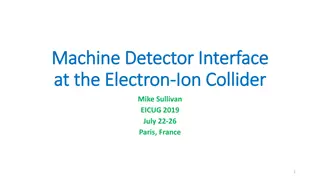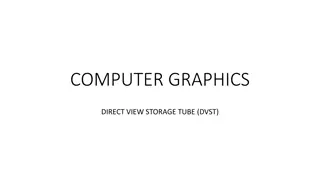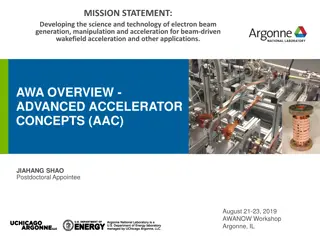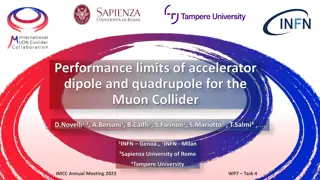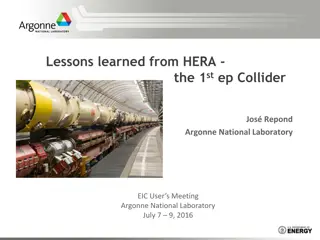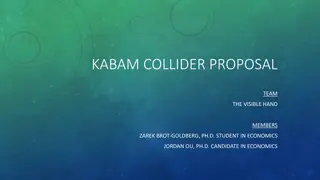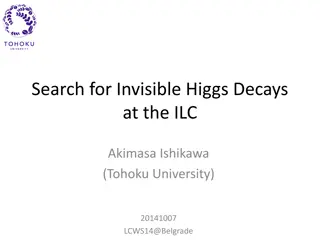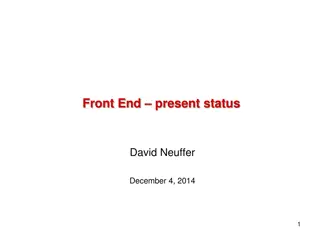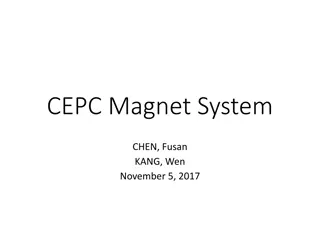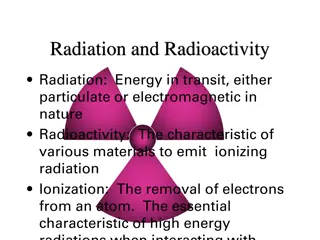SuperKEKB: Advancements in Electron-Positron Collider Technology
SuperKEKB is a cutting-edge circular collider facility that aims to push the boundaries of high-energy physics research. From addressing cloud challenges to conducting instability simulations, the facility has made significant strides in understanding beam dynamics and electron cloud effects. The commissioning phases, beam size blow-up observations, and systematic studies have all contributed to enhancing the collider's performance and efficiency. The research conducted at SuperKEKB is crucial for the future of particle physics and collider technology.
Download Presentation

Please find below an Image/Link to download the presentation.
The content on the website is provided AS IS for your information and personal use only. It may not be sold, licensed, or shared on other websites without obtaining consent from the author. Download presentation by click this link. If you encounter any issues during the download, it is possible that the publisher has removed the file from their server.
E N D
Presentation Transcript
E E- -cloud challenges at SuperKEKB cloud challenges at SuperKEKB and future colliders and future colliders K. Ohmi (KEK) ECLOUD2018, June 3-7, 2018 Italy, La Biodola Bay, Isola d'Elba Thanks to J. Flanagan, H. Fukuma, Y. Suetsugu, M. Tobiyama
SuperKEKB C=3016.3m, e+(4GeV)-e-(7GeV) circular collider Half crossing angle, c=41.5mrad, z=6/5mm. Phase 2.3 ( 4x8x) Phase 2 (May 2018) Design LER HER LER HER LER HER x*[mm] y*[mm] x[nm] y/ x[%] Ib[mA] x y Nbunch L [cm-2s-1] PA c 200 200 128 100 32 25 4 4 2.16 2.40 0.27 0.30 2.1 4.6 2.1 4.6 3.2 4.6 5 1.4 0.27 0.28 340 285 0.64 0.51 1.44 1.04 0.0053 0.0021 0.0028 0.0012 0.019 0.013 0.0484 0.05 0.088 0.081 788 1576 2500 1.3x1033 2x1034 8x1035 10 8 15.2 9.7 24.7 19.4
Instability simulation at SuperKEKB design stage Using code PEHTS e=4.2x1011at 4000-th turn Simulation, eth=3.8x1011m-3. Design target for vacuum system: e<1011m-3in average of whole ring
KEKB: measurement and simulation of fast head-tail instability Simulation (PEHTS) Beam size blow up observed, and simultaneously synchro- beta sideband observed. J. Flanagan et al., PRL94, 054801 (2005) HEADTAIL gave similar results (E. Beneditto showed large cloud gave nice sideband signal) Betatron sideband Tail of train > s Measurement at KEKB Head of train e,th=0.8x1012m-3
Phase I commissioning 2017 Feb.-June No collision. Test as two storage rings, e+(LER) and e-(HER). I=1A(e+) and 0.8A(e-) were stored. Electron cloud studies were performed. Beam size blow-up was seen, but was recovered by permanent solenoid magnets.
Beam size blow-up in LER Beam-size blowup observed in KEKB has been seen in early stage of SuperKEKB commissioning 1. Threshold I~300mA in Apr 19 (Y. Funakoshi) 2. Electron cloud has been monitored at AL chamber w and w/o TiN coating (Y. Suetsugu). 3. Beast study threshold I~600mA, Nbunch=1576 in May 17 (Nakayama et al) 4. Aluminum bellows, which were not coated by TiN, were suspected as an electron source. 5. Permanent magnets were installed at the aluminum bellows.(Y. Suetsugu et al.) 6. The blow up was suppressed. Systematic studies in 8 July ( H. Fukuma et al.) y Before perm. mag installation June 1, 2016 4 train x150 bunches, Nbunch=600 Threshold beam current 160, 200, 260,500 mA for 2, 3, 4, 6 bucket spacing H. Fukuma et al.,
Simulation studies using beam study condition Threshold of the electron density x=2nm, y=15pm, z=6mm, s=0.019 Np=1.6x1010 Ith=160mA, 4ns spacing Np=2.7x1010 Ith=260mA, 8ns spacing Np=3.65x1010, Ith=350mA, 6ns Np=6.25x1010, I=600mA, 8ns Np=5.2x1010 Ith=500mA, 8ns spacing Np=2.1x1010 Ith=200mA, 6ns spacing
Electron density at the blow-up threshold Simulated electron density at the threshold current Measured threshold current and density Only Al part 5% of whole ring Simple formula Q=7
Instability threshold Threshold electron density is higher for higher bunch current. K, which characterize the number of electron contributing instability, seems saturate. Simulation also indicates the same feature.
After installation of permanent solenoid at Al bellows Simulated electron density at the threshold current y After : 2016/6/8 Ith=200 mA Ith=330 mA 4/150/2 4/150/3 4/150/4 Ith>600 mA Ith/600bunches 160mA to 200mA by 2 bucket 200mA to 330mA by 3 260mA to >600mA by 4 SuperKEKB nbunch=1500-2500 Simple formula Q=7
Simulated threshold electron density (before/after permanent magnet installation) Nb=600, x=1.9nm, y=15pm, z=6mm, s=0.019 e/2 (GHz) (1011m-3) (1011m-3) e z/c eth(Q,K=7) eth(Q=7) eth(Simu) (1011m-3) Np,th (1010) spacing Ip,th(mA) 1.6 56 7.0 2.45 2.45 3.2 2 (4ns) 160 2.1 63 8.0 2.75 2.45 3.4 3 (6ns) 200 2.7 72 9.1 3.12 2.45 3.6 4 (8ns) 260 5.2 100 12.6 4.33 2.45 4.0 6 (12ns) 500 2.1 63 8.0 2.45 2.45 3.4 2 (4ns) 200 3.65 84 10.6 3.63 2.45 3.8 3 (6ns) 350 6.25 110 13.8 4.75 2.45 4.2 4 (8ns) >600
Tune shift measurement along bunch train Tune shift along bunch train in LER Ohmi,Tobiyama,Fukuma ??= ?? ??=?????? ??= 8 1011m-3 ??=0.005 ? 2? ??= 0 ??=?????? ??= 4 1011? 3 Agree with density measurement ? ??= 0.005 ?
Coupled bunch instability High R/Q and Low Q=1 Lower R/Q and higher Q=10 Growth of CBI is similar as drift electron. R= prec2/r2 c
CBI in bend Corrective motion of beam and electron stripe. Hor. slowest mode is excited. (DAFNE) Unstable mode spectrum is closely related to the motion of electron cloud.
Phase II commissioning Start from March 2018 Squeezing *. (200mmx4mm in May 2018) Measurement of electron cloud instabilities, coupled bunch and single bunch instabilities on 29 May. Solenoid type of modes were observed in coupled bunch modes (growth~4ms, talk by Tobiyama). No single bunch instability (beam size blow-up) 0.6mA/bunch, Lsp>=4ns (Design 1.4mA/b, 4ns). Electron cloud is well controlled (talk by Suetsugu). Note: Design current increases (1.4mA/b) and vertical emittance squeeze, now 2-3% to design 0.3% in next year (Phase III). Electron cloud effect in IR section with very high beta.
IR optics 8x8x design Extremely high beta ~2000 m. Even the length is short, contribution may be dominant. Betatron phase is separated each high beta area. Resonances with high harmonics are excited. 3000 by fy 1.75 2500 1.25 0.75 2000 0.25 1500 by fy -0.25 1000 -0.75 -1.25 500 -1.75 0 -100 -50 0 50 100 s (m)
Model for local electron density at IR 3000 1 180 1 bx by bx by 160 re,1 re,2 2500 re,1 re,2 0.8 0.8 140 2000 120 re/1011 m-3 0.6 re/1011 m-3 0.6 100 bx,y 1500 bx,y 80 0.4 0.4 1000 60 0.2 40 500 0.2 20 0 0 0 0 0 20 40 60 80 100 500 1000 1500 s (m) 2000 2500 s (m) Density of IR magnets e~1010m-3. Bending magnets for local chromaticity correction are insatlled at IR. Density at QLC3LP and QLB1LP can be higher e~1011m-3.
Tune shift and electron frequency of electron cloud at IR 50 0.0016 0.00012 case 1 case 2 local dny 0.0014 0.0001 40 0.0012 8e-05 0.001 30 Dny wsz/c 0.0008 6e-05 0.0006 4e-05 20 0.0004 2e-05 0.0002 10 0 0 0 500 1000 1500 2000 2500 3000 s (m) 0 0 500 1000 1500 2000 2500 3000 s (m) 70% of the tune shift comes from QC s. (focus case 2)
Beam motion (PEHTS) Design base 2x1010m-3in QC s Coherent instability threshold, 1.4x1011m-3in QC s Incoherent emittance growth is seen at 8x1010m-3.
Radiation damping and equilibrium vertical emittance Radiation damping ~5000 turns is taken into account. at re=6x1011at QC s, emittance increases 20%.
Summary for electron cloud effects in SuperKEKB Electron cloud is controlled by 0.6mA/b for 4ns s pacing at least. Coupled bunch instability is manageable and single bunch instability threshold is higher. Final goal of SuperKEKB is 1.2mA/b. IR beta is extremely high and betatron phase difference is . IR density should be less than 8x1010m-3against coherent instability and incoherent emittance growth J. Crittenden estimated that electron density in QCS is 1014m-3. This density, which is surprisingly high gives strong instability and emittance growth. SR should be protected carefully in IR. Do we measure CBI mode related to electrons in quadrupole? At present, no, and we hope no in the future.
Electron cloud instability in FCCee Z (45.5GeV) Higgs (120GeV) CEPC-Z FCCee-Z CEPC-H FCCee-H x(nm)/ y(pm) x/ y (mm) z(mm)/ z,BS(mm) (mrad), P Ne Nbunch, tsp(ns) Ltot(cm-2s-1) x/ y 0.17/2.9 0.27/1.0 1.21/3.6 0.63/1.3 360/2 150/0.8 360/2 300/1 3.67/5.18 3.5/12.1 2.72/3.48 3.15/4.9 0.0165, 10.8 0.015, 28.5 0.0165,2.75 0.015, 5.3 1.6-4.8x1010 17x1010 12.9x1010 15x1010 10900, 35 16640, 20 286 393 1-9 230 2.0 7.8 0.005-0.015/ 0.0165- 0.048 0.004/0.133 0.024,0.094 0.016/0.108
Electron production Number of photon emitted by an positron E=45.5GeV ??=5? ?? ? 1 ? = 137 3 N =0.06m-1(, C=100km) PEY=0.1 (number of electron produced by a photon) Npe=0.006 m-1. (number of electron produced by a positron) CEPC-Z & FCCee-Z Nb=4.8e10 & 17e10 , bunch spacing 35 ns & 20 ns The number of electron produced by an e+bunch NpeNb=2.9x108m-1& 1.0x109m-1 Beam line density, b=4.6x109m-1& 2.8x1010m-1
Electron cloud density in drift space Chamber r=3cm cylindrical. ~2.9x108m-1 Electron line density when next bunch arrives e=1.4x108/0.0033=4x1010m-3.
Electron cloud density in bending magnet Direct emitted photon create electrons at the side of chamber. The electrons do not come to the chamber center. Synchrotron radiation reflected. Assume 10% of primary photon hit wall uniformly. 0.6x1010 1x1010
Other parameter cases Np=8e10, tsp=35ns Np=8e10, 20ns 1x1010 1x1010 0.6x1010 Central density does not increase so much compare with the line density. Coupled bunch instability may occur.
Threshold density for single bunch electron cloud instability Electron oscillation inside a positron bunch Positron line density e z/c=13.6, x= y=50m, z=4.33mm,Np=4.8e10 e z/c=17.6 x= y=50m, z=4.33mm,Np=8.e10 e z/c=36.6, x= y=50m, z=12.1mm,Np=17.e10 Threshold e,th=2.9x1010m-3 e,th=2.9x1010m-3 e,th=1.87x1010m-3. e(drift)=5.5x1010m-3 e(bend)=1x1010m-3. 17e10 e(drift)=5x1010m-3 e(bend)=0.6x1010m-3. 4.8e10 e(drift)= 7x1010m-3 e(bend)= 1x1010 m-3. 8e10, 35ns & 20ns
Summary for electron cloud effects in FCCee Electron cloud build up for CEPC-Z, FCCee-Z have been studied. Area w/wo bending magnet is 6/1. CEPC 4.8e10, 35ns e,ave=5/7+0.6*6/7=1.2x1010cm-3. 8e10 , 35ns e,ave=7/7+1*6/7=1.86x1010cm-3. FCCee-Z e,ave=5.5/7+1*6/7=1.64x1010cm-3. Normal cell consists of 60m bend and 10m drift Threshold CEPC 4.8e10: e,th=2.9x1010m-3, 8e10: e,th=2.9x1010m-3 FCCee-Z: e,th=1.87x1010m-3 All 4 cases for CEPC-Z, Np=4.8e10, Np=8e10, tsp=35ns and 20ns, are stable for electron cloud single bunch instability. FCCee is also safe for the single bunch instability. Electrons in bending should be analyzed in detail, where electron stripe is located.
Beam motion (PEHTS) Design base 2x1010in QCS s ave 2x1010and 1011in QLB ,C
Radiation damping and equilibrium vertical emittance
Unstable mode of CBI Unstable mode spectrum is closely related to the motion of electron cloud. Electrons in drift space induces a low Q=1 wake with fR=several ns. Electrons in weak solenoid magnet induces a high Q=10 wake with R= prec2/r2 c. c=eB/m, r:electron orbit raduis. Electrons in bending magnets induces a slow frequency wake coupled to motion of stripe structure. Electrons in quadrupole ... may be important to study effects at IR section in colliders.
